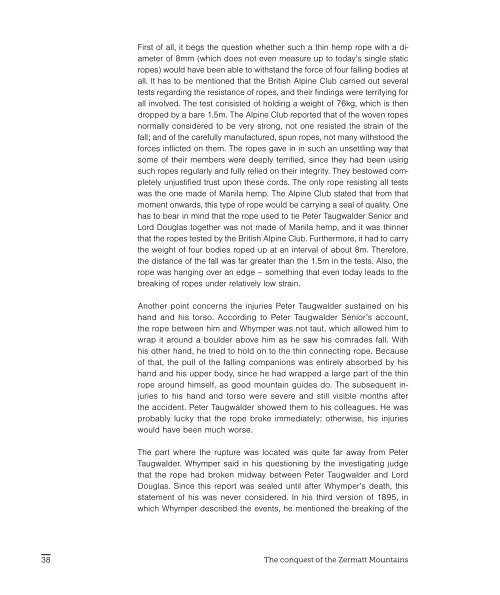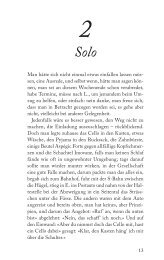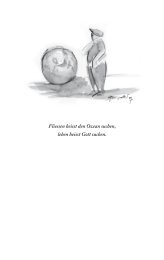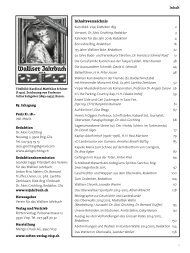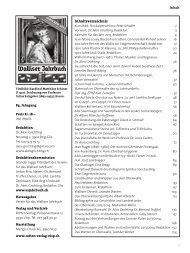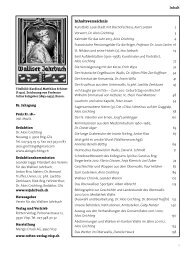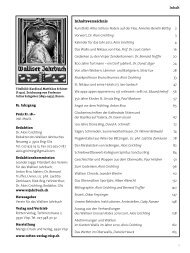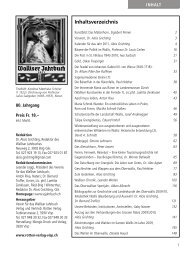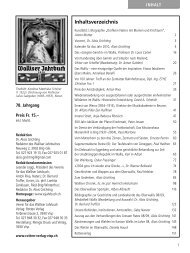Biner_Leseprobe
You also want an ePaper? Increase the reach of your titles
YUMPU automatically turns print PDFs into web optimized ePapers that Google loves.
First of all, it begs the question whether such a thin hemp rope with a diameter<br />
of 8mm (which does not even measure up to today’s single static<br />
ropes) would have been able to withstand the force of four falling bodies at<br />
all. It has to be mentioned that the British Alpine Club carried out several<br />
tests regarding the resistance of ropes, and their findings were terrifying for<br />
all involved. The test consisted of holding a weight of 76kg, which is then<br />
dropped by a bare 1.5m. The Alpine Club reported that of the woven ropes<br />
normally considered to be very strong, not one resisted the strain of the<br />
fall; and of the carefully manufactured, spun ropes, not many withstood the<br />
forces inflicted on them. The ropes gave in in such an unsettling way that<br />
some of their members were deeply terrified, since they had been using<br />
such ropes regularly and fully relied on their integrity. They bestowed completely<br />
unjustified trust upon these cords. The only rope resisting all tests<br />
was the one made of Manila hemp. The Alpine Club stated that from that<br />
moment onwards, this type of rope would be carrying a seal of quality. One<br />
has to bear in mind that the rope used to tie Peter Taugwalder Senior and<br />
Lord Douglas together was not made of Manila hemp, and it was thinner<br />
that the ropes tested by the British Alpine Club. Furthermore, it had to carry<br />
the weight of four bodies roped up at an interval of about 8m. Therefore,<br />
the distance of the fall was far greater than the 1.5m in the tests. Also, the<br />
rope was hanging over an edge – something that even today leads to the<br />
breaking of ropes under relatively low strain.<br />
Another point concerns the injuries Peter Taugwalder sustained on his<br />
hand and his torso. According to Peter Taugwalder Senior’s account,<br />
the rope between him and Whymper was not taut, which allowed him to<br />
wrap it around a boulder above him as he saw his comrades fall. With<br />
his other hand, he tried to hold on to the thin connecting rope. Because<br />
of that, the pull of the falling companions was entirely absorbed by his<br />
hand and his upper body, since he had wrapped a large part of the thin<br />
rope around himself, as good mountain guides do. The subsequent injuries<br />
to his hand and torso were severe and still visible months after<br />
the accident. Peter Taugwalder showed them to his colleagues. He was<br />
probably lucky that the rope broke immediately; otherwise, his injuries<br />
would have been much worse.<br />
The part where the rupture was located was quite far away from Peter<br />
Taugwalder. Whymper said in his questioning by the investigating judge<br />
that the rope had broken midway between Peter Taugwalder and Lord<br />
Douglas. Since this report was sealed until after Whymper’s death, this<br />
statement of his was never considered. In his third version of 1895, in<br />
which Whymper described the events, he mentioned the breaking of the<br />
38 The conquest of the Zermatt Mountains


